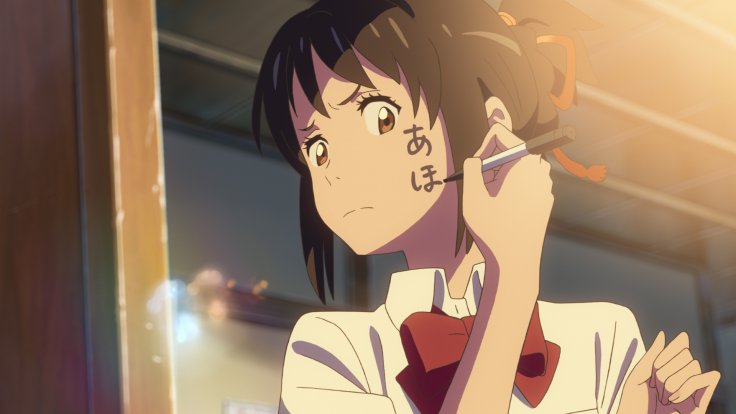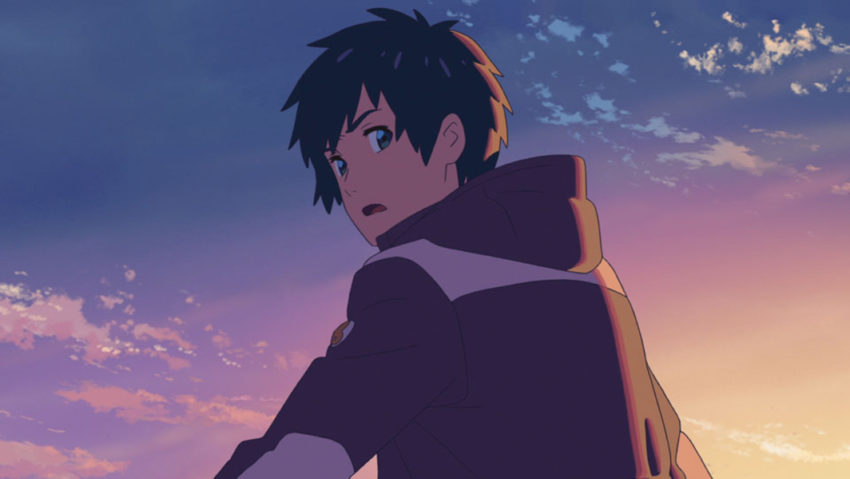Your Name
April 12, 2021 · 0 comments
By Shelley Pallis.

The forthcoming re-release of Makoto Shinkai’s world-beating romance Your Name is a perfect opportunity to revisit his 2016 blockbuster, and to poke around in some of the on 4K Blu-ray gossip and behind-the-scenes stories of its inception. The liner notes alone are thick with details liable to pass even hard-core fans by after repeat viewings, including some insightful questions from Japanese fans, answered by the ever-gracious Shinkai himself.
Shinkai’s story, of Mitsuha, a Japanese girl, and Taki, a Japanese boy whose personalities inexplicably and repeatedly swap across time and space, is well known to anime fans. But I can still take great delight in the kind of details that sharper eyes than mine have teased out, such as the fact that the Moon in the film is only ever shown as a crescent. Shinkai even has an answer for that: “It represents the state,” he explains, “that half, which is to say Mitsuha, is missing.”
Shinkai’s original proposal, which had the working title If I’d Known It was a Dream… was openly pitched to producers as a retelling of a story from old-time Japan, Torikaebaya Monogatari or The Story of the Changelings. Believed to have been written at some point in the 12th century, the original story features a minister in the Heian court who muses that he would be better off if his tomboy daughter and milksop son somehow swapped personalities. Consequently, he decides to raise each as the opposite gender. His daughter, stuffed into male clothes, becomes a go-getting hero at the court, while his son, suitably dolled up, becomes a coquettish imperial consort who keeps avoiding being left alone with the emperor.

The Story of the Changelings was considered a “perverse” and “decadent” work in the Japan’s early modern era, derided by critics for “betraying its readers”, although it clearly contained some intriguing and precocious considerations of socially defined gender roles – we might say it was centuries ahead of its time, and has only come to be fully appreciated in recent decades.
Eventually the tengu crow-demon who cursed the children to be dissatisfied with their normal roles has a change of heart, converts to Buddhism, and releases them from their torments. It ends with “normality” restored, but not before there has been plenty of drama over marital affairs and secret trysts, and loves that dare not speak their name. The story was translated into English by Rose Willig as The Changelings in 1983.
Shinkai perceptively observes that The Story of the Changelings was the inspiration for a whole slew of body-swap stories in modern Japanese media, but that the nature of the difference between the swappers changed depending on the times. “Despite the differences in tone, ‘swapping’ in any piece brings into relief the differences between the sexes,” he writes. “In the Heian period, the difference was expressed in the difference between the gender that gives birth, and the gender that makes birth happen. In a [late twentieth century] story, it would be the difference in social expectations between the masculine and the feminine. In a story from the Heisei era [i.e. the 2010s], it is the difference in social standing between an unpopular, nerdy man and a shining high school girl.”
Shinkai’s initial proposal wanted the two leads to only swap dreams, alluding to a quote from an old Japanese poem in the Hyakunin Isshu anthology: “I fell asleep thinking of you and saw you in my dream, and if I’d known it was a dream, I wouldn’t have woken up…”

But why Taki? Why is it that nerd, of all the nerds, who ends up swapping bodies with Mitsuha? Asked that question in a fan-forum, Shinkai replies: “In early drafts, there was the idea that she swaps with other people, as if she’s tuning a radio, before she properly connects with Taki in the dream. But in the end, I chose not to depict any reason as to why it was Taki, because there is no reason in reality why one person meets another, or falls in love with them. Explanations can make the story poorer.” His refusal to explain everything has within it a pre-sentiment of similar naturalism in his later Weathering with You, in which his hero’s reasons for leaving his home-town are never addressed.
In another foreshadowing of Weathering with You, Shinkai gave his characters names based on water features – Mitsuha derives her name from the water goddess Mitsuhame, but also from another poem, from the same Hyakunin Isshu anthology that provided the one above, about a rock that divides a waterfall (taki), only for the parted waters to be reunited: “Though a swift stream is / Divided by a boulder / In its headlong flow …”
Separation, and yearning for something that is lost, has been a feature of all of Shinkai’s works, including Voices of a Distant Star and 5 Centimeters per Second. He noted in the same Q&A event that when it came to Your Name, his evocation of a romance between a city boy and a country girl was not merely about two people falling in love, but about his own speculation about the different paths his own life might have taken.
“We cannot exist in two places at the same time,” he said. “I love nature in my home town and the artificial wealth of Tokyo, and in the end, I have chosen to live in Tokyo. But I could have lived in my hometown, and I could have found happiness there.”
Your Name is released on 4K Blu-ray by Anime Limited.
Leave a Reply